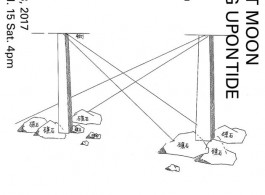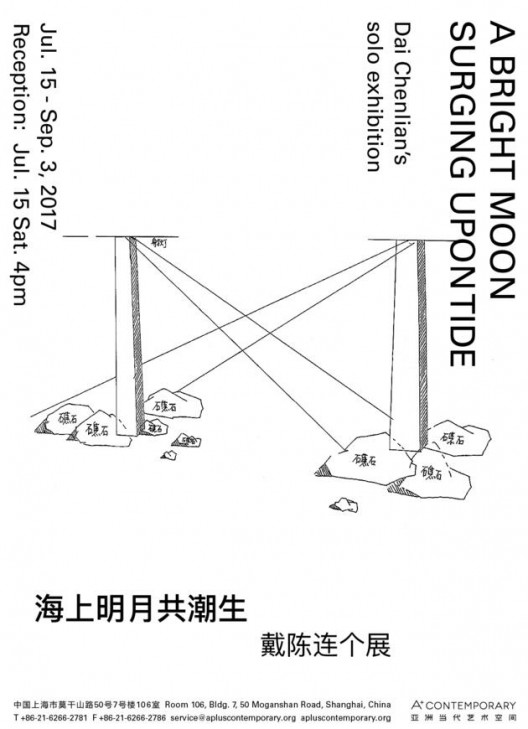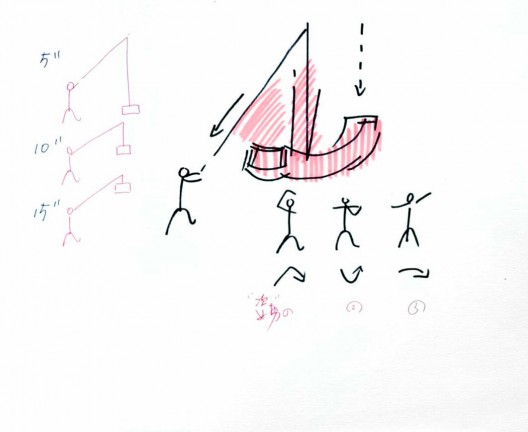A+ Contemporary is pleased to announce the opening of artist Dai Chenlian’s solo exhibition “A Bright Moon Surging Upon Tide” on July 15th, 2017. The exhibition is on view through September 3rd.
With a degree in Oil Painting from China Academy of Art, Dai Chenlian shifted his focus to the creative practices of theatre after graduation. Through the representation of time, language and theatre’s innate quality, Dai queries and reconsiders questions revolving around the creative methods, motives of exhibiting, forms of artwork and so forth.
This exhibition is a new interpretation which follows the same train of thought as Dai Chenlian’s Family Theater Project. The exhibition is named after the famous poem “A Flowery Moonlit Night by the Spring River” by Zhang Ruoxu, a poet from the Tang Dynasty. The artist borrows from the imagery of the poetic verses to construct a space where various art forms, such as performance, painting, text, sound, video and installation interact with one another.
With the artist pursuing the historical clues left by a small raft as it drifted across the ocean and finally sought shelter in Shanghai, an invitation is granted to begin detailing and imagining the individual experiences of gallerists.
The following conversation between A+ Contemporary (short for A+) and Dai Chenlian (short for Dai) will hopefully serve to inspire a more flexible understanding of this exhibition which differentiates from a purely visual one.
A+: What are the sources of inspiration and creative incentive for this exhibition?
Dai: I often ask myself why I do exhibitions and why in a gallery. When I finished the preliminary draft of this exhibition, I realized the most moving performances where the conception and the illustrating process – all actions of this site are complete. I therefore adopt the thought process of the draft as part of the final display. The same trail of thinking is visible in my performance works as well.
The background story is actually about the entire exhibition planning team of A+ Contemporary. Each of these people is a small individual – more details are revealed upon closer looks, enabling the otherwise blurred histories and dreams to be made in focus and in freeze frame again. This is the story of a drifting raft on the ocean finally arriving in Shanghai, carrying hundreds of years of history. Their every move in Shanghai is a reminder of the howling ocean winds and the rhythms of waves colliding, which in turn influences the bent-over position of the fisherman as they cast their nests, the rustles as ocean winds gently shake the leaves and a mother’s songs that softly kiss her sleeping children. These actions that are at times soft and at times aggressive tug at the overlapped and ambiguous historical clues.
A+: The exhibition title is named after the poem “A Flowery Moonlit Night by the Spring River” by poet Zhang Ruoxu of Tang Dynasty. Is it a deliberation concerning the exhibition’s form or of a different significance to choose the verse “A Bright Moon Surging Upon Tide”?
Dai: The original verse possesses both imagery and affection, melding into one as they interlace. The poem employs a rhyme transition every four verses and a linked-verse tangles the level and oblique tones, its rhythm delicate like a scenery poem; just as the method of performance and exhibition here, there involves the implicit and explicit significance, reflections between text and scenery, sound and scenery – these indicate the brilliant dream for the future shared across the straits, and indicate the location, character, time, and shift in time tense as well as quality of actions where actions occur. These text, painting, installation and other elements interweave with one another to create a symphony-like structure.
A+: Why choose to create a work about the gallery’s own story in the gallery? Could this be interpreted as a reflection of individual experiences under the relocation of societal and geographical context or a wider consideration of the system?
Dai: A part of my work includes “Family Theater Project”, which through a method similar to that of a documentary, positions the artist (or other professionals) as subject with various forms of art exhausted and applied to “modify” theatre with materials such as individual experiences and characteristics. The narratives and imaginations of contemporary China are revealed to outline the cost and fate that an average person must bear in this age of social transformation, uncovering emotions and events ignored or veiled by appropriate actions. The solo exhibition at A+ Contemporary is a brand-new interpretation of this concept.
A+: Paintings are included in the exhibition space alongside installations – could you briefly speak of the exhibiting paintings? What clues of looking do these paintings provide?
Dai: The painting is, in fact, the exhibition itself, while within this manufactured world of drafts are the analogous wall paintings, watercolor on papers, sketches and painting on canvases that refer to the unique quality of mutual guidance and contrast between multiple texts. The exhibition does not propose a fixed perspective, allowing the audience to enter through any one of the works.
A+: Your work combines many forms such as performance, painting, installation, text, video and more. How do you consider the theatricality of your work? Aside from the interactions between these constructing elements, how does a work’s theatricality associate itself with the space?
Dai: I believe in the playful emphasis on autonomy as constructed by music, space, performance and more. Self-worth should first be developed to then exercise its function as it makes connections with other elements and forms. In a lot of my works, the individuality of installation, the physical process onsite, particular performers, singers, paintings, and video all complement one another without a distinguished hierarchy while the emphasized text, installation and painting interact with one another in a space.
Most of my works are rooted in space. A work’s final form is determined through observation, reflection, the lines and angles of space, the quality of architecture in combination with the existing space. Imagery symbol, performance, posture, installation, text and painting are forced to strike a form of connection while the previously rehearsed parts start and pause incessantly as the environment, installation, text, theatre and space come together as one. It is not a simple overlay of every method of expression but a series of mutual reactions. The brilliant effects of multimedia are not sought after but rather the process to realize what’s beyond the effects.
A+: Aside from the exhibition itself, this solo exhibition includes a live performance during the opening. Could you reveal a bit about the concept behind the performance? What is the connection between performance and exhibition?
Dai: The exhibition will be a directive performance – this is a direct theatre about the form of presentation; the approach of “commands” are used to “propose questions” onsite with “direct interceptions” replacing “acting”, “commands” canceling subject and object, “display motions” connecting the dots of historical imagery.





